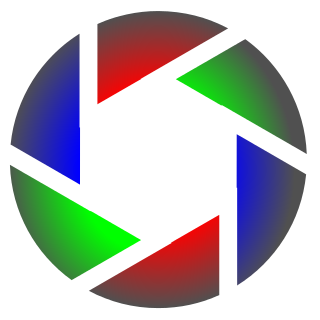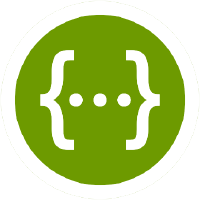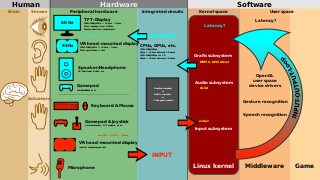Middleware in the context of distributed applications is software that provides services beyond those provided by the operating system to enable the various components of a distributed system to communicate and manage data. Middleware supports and simplifies complex distributed applications. It includes web servers, application servers, messaging and similar tools that support application development and delivery. Middleware is especially integral to modern information technology based on XML, SOAP, Web services, and service-oriented architecture.

Gesture recognition is a topic in computer science and language technology with the goal of interpreting human gestures via mathematical algorithms. Gestures can originate from any bodily motion or state but commonly originate from the face or hand. Current focuses in the field include emotion recognition from face and hand gesture recognition. Users can use simple gestures to control or interact with devices without physically touching them. Many approaches have been made using cameras and computer vision algorithms to interpret sign language. However, the identification and recognition of posture, gait, proxemics, and human behaviors is also the subject of gesture recognition techniques. Gesture recognition can be seen as a way for computers to begin to understand human body language, thus building a richer bridge between machines and humans than primitive text user interfaces or even GUIs, which still limit the majority of input to keyboard and mouse and interact naturally without any mechanical devices. Using the concept of gesture recognition, it is possible to point a finger at this point will move accordingly. This could make conventional input on devices such and even redundant.
The Speech Application Programming Interface or SAPI is an API developed by Microsoft to allow the use of speech recognition and speech synthesis within Windows applications. To date, a number of versions of the API have been released, which have shipped either as part of a Speech SDK or as part of the Windows OS itself. Applications that use SAPI include Microsoft Office, Microsoft Agent and Microsoft Speech Server.
Mobile app development is the act or process by which a mobile app is developed for mobile devices, such as personal digital assistants, enterprise digital assistants or mobile phones. These applications can be pre-installed on phones during manufacturing platforms, or delivered as web applications using server-side or client-side processing to provide an "application-like" experience within a Web browser. Application software developers also must consider a long array of screen sizes, hardware specifications, and configurations because of intense competition in mobile software and changes within each of the platforms. Mobile app development has been steadily growing, in revenues and jobs created. A 2013 analyst report estimates there are 529,000 direct app economy jobs within the EU 28 members, 60% of which are mobile app developers.
OpenGate is a communications platform designed to facilitate a fast development and deployment of robust wireless solutions, to be used as a M2M platform or as a mobile platform.
A mobile operating system is an operating system for phones, tablets, smartwatches, or other mobile devices. While computers such as typical laptops are 'mobile', the operating systems usually used on them are not considered mobile ones, as they were originally designed for desktop computers that historically did not have or need specific mobile features. This distinction is becoming blurred in some newer operating systems that are hybrids made for both uses.

Opticks is a remote sensing application that supports imagery, video, synthetic aperture radar (SAR), multi-spectral, hyper-spectral, and other types of remote sensing data. Opticks supports processing remote sensing video in the same manner as it supports imagery, which differentiates it from other remote sensing applications. Opticks was initially developed by Ball Aerospace & Technologies Corp. and other organizations for the United States Intelligence Community. Ball Aerospace open sourced Opticks hoping to increase the demand for remote sensing data and broaden the features available in existing remote sensing software. The Opticks software and its extensions are developed by over twenty different organizations, and over two hundred users are registered users at http://opticks.org. Future planned enhancements include adding the ability to ingest and visualize lidar data, as well as a three-dimensional (3-D) visualization capability.
FBX (Filmbox) is a proprietary file format (.fbx) developed by Kaydara and owned by Autodesk since 2006. It is used to provide interoperability between digital content creation applications. FBX is also part of Autodesk Gameware, a series of video game middleware.

A smart TV is a traditional television set with integrated Internet and interactive "Web 2.0" features which allows users to stream music and videos, browse the internet, and view photos. Smart TV is a technological convergence of computers, television sets and set-top boxes. Besides the traditional functions of television sets and set-top boxes provided through traditional broadcasting media, these devices can also provide Internet TV, online interactive media, over-the-top content (OTT), as well as on-demand streaming media, and home networking access.

Android software development is the process by which new applications are created for devices running the Android operating system. Google states that "Android apps can be written using Kotlin, Java, and C++ languages" using the Android software development kit (SDK), while using other languages is also possible. All non-JVM languages, such as Go, JavaScript, C, C++ or assembly, need the help of JVM language code, that may be supplied by tools, likely with restricted API support. Some languages/programming tools allow cross-platform app support, i.e. for both Android and iOS. Third party tools, development environments and language support have also continued to evolve and expand since the initial SDK was released in 2008. In addition, with major business entities like Walmart, Amazon, Bank of America etc. eyeing to engage and sell through mobiles, mobile application development is witnessing a transformation.

Marmalade SDK is a cross-platform software development kit and game engine from Marmalade Technologies Limited that contains library files, samples, documentation and tools required to develop, test and deploy applications for mobile devices.

Sailfish OS is a general purpose Linux distribution used commonly as a mobile operating system combining the Linux kernel for a particular hardware platform, the open-source Mer core stack of middleware, a proprietary UI contributed by Jolla or an open source UI, and other third-party components.

Omek Interactive was a venture-backed technology company developing advanced motion sensing software for human-computer interaction. Omek was co-founded in 2007 by Janine Kutliroff and Gershom Kutliroff.
Dialogflow is a Google-owned developer of human–computer interaction technologies based on natural language conversations. The company is best known for creating the Assistant, a virtual buddy for Android, iOS, and Windows Phone smartphones that performs tasks and answers users' question in a natural language. Speaktoit has also created a natural language processing engine that incorporates conversation context like dialogue history, location and user preferences.
Intel RealSense Technology is a suite of depth and tracking technologies designed to give machines and devices depth perceptions capabilities that will enable them to "see" and understand the world. There are many uses for these computer vision capabilities including autonomous drones, robots, AR/VR, smart home devices amongst many others broad market products. RealSense technology is made of Vision Processors, Depth and Tracking Modules, and Depth Cameras, supported by an open source, cross-platform SDK called librealsense that simplifies supporting cameras for third party software developers, system integrators, ODMs and OEMs.

Swagger is an open-source software framework backed by a large ecosystem of tools that helps developers design, build, document, and consume RESTful Web services. While most users identify Swagger by the Swagger UI tool, the Swagger toolset includes support for automated documentation, code generation, and test-case generation.















